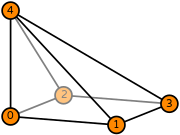an encyclopedia of finite element definitions
Degree 1 Lagrange on a pyramid
◀ Back to Lagrange definition page
- \(R\) is the reference pyramid. The following numbering of the sub-entities of the reference cell is used:
- \(\mathcal{V}\) is spanned by: \(1\), \(y\), \(x\), \(- \frac{x y}{z - 1}\), \(z\)
- \(\mathcal{L}=\{l_0,...,l_{4}\}\)
- Functionals and basis functions:

\(\displaystyle l_{0}:v\mapsto v(0,0,0)\)
\(\displaystyle \phi_{0} = \frac{- x y + \left(z - 1\right) \left(- x - y - z + 1\right)}{z - 1}\)
This DOF is associated with vertex 0 of the reference cell.
\(\displaystyle \phi_{0} = \frac{- x y + \left(z - 1\right) \left(- x - y - z + 1\right)}{z - 1}\)
This DOF is associated with vertex 0 of the reference cell.
\(\displaystyle l_{1}:v\mapsto v(1,0,0)\)
\(\displaystyle \phi_{1} = \frac{x \left(y + z - 1\right)}{z - 1}\)
This DOF is associated with vertex 1 of the reference cell.
\(\displaystyle \phi_{1} = \frac{x \left(y + z - 1\right)}{z - 1}\)
This DOF is associated with vertex 1 of the reference cell.
\(\displaystyle l_{2}:v\mapsto v(0,1,0)\)
\(\displaystyle \phi_{2} = \frac{y \left(x + z - 1\right)}{z - 1}\)
This DOF is associated with vertex 2 of the reference cell.
\(\displaystyle \phi_{2} = \frac{y \left(x + z - 1\right)}{z - 1}\)
This DOF is associated with vertex 2 of the reference cell.
\(\displaystyle l_{3}:v\mapsto v(1,1,0)\)
\(\displaystyle \phi_{3} = - \frac{x y}{z - 1}\)
This DOF is associated with vertex 3 of the reference cell.
\(\displaystyle \phi_{3} = - \frac{x y}{z - 1}\)
This DOF is associated with vertex 3 of the reference cell.
\(\displaystyle l_{4}:v\mapsto v(0,0,1)\)
\(\displaystyle \phi_{4} = z\)
This DOF is associated with vertex 4 of the reference cell.
\(\displaystyle \phi_{4} = z\)
This DOF is associated with vertex 4 of the reference cell.